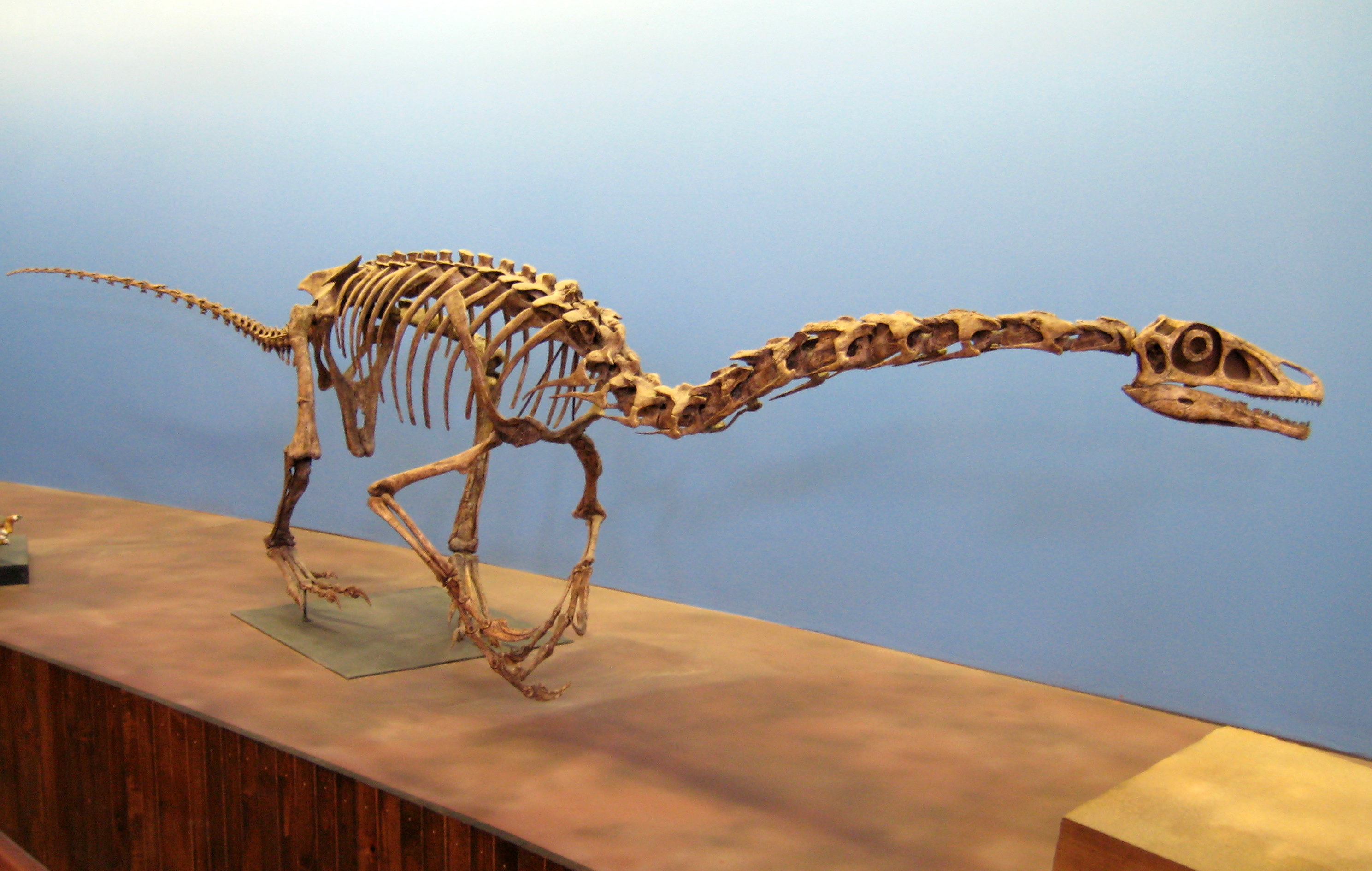- Falcarius
Taxobox|
name = "Falcarius"
fossil_range =Early Cretaceous

image_width = 250px
image_caption = "Falcarius" skeleton reconstruction, Utah Museum of Natural History.
regnum =Animal ia
phylum = Chordata
classis =Sauropsid a
superordo =Dinosaur ia
ordo =Saurischia
subordo =Theropoda
infraordo =Coelurosauria
superfamilia =Therizinosauroidea
genus = "Falcarius"
binomial = "Falcarius utahensis"
binomial_authority = Kirkland "et al.", 2005"Falcarius" was a
therizinosaur iandinosaur genus found in east-centralUtah , in theUnited States , in 2005. Its name is derived from the word "sickle " ('falcarius' inLatin being a sickle cutter), which scientists have used to describe its unwieldy clawed hands. This find, along with the recently discovered therizinosauroid "Beipiaosaurus " from the EarlyCretaceous ofChina , may clarify the group's relationship with the larger family oftheropod dinosaurs.The discovery site, in a 2 acre (8,000 square meter) area of Utah's Cedar Mountain Formation, includes the remains of hundreds, perhaps thousands, of specimens of the new species. Only a small number of the available fossils have been excavated. From examining
fossil ized bones from several individual animals, scientists describe the dinosaurs as feathered, rotund, sickle-clawed creatures. "Falcarius utahensis" averaged 3.7 to 4 m (12 to 13 ft) in length and just over 1.2 m (4 ft) tall. With its long neck, it could apparently reach about 1.5 m (5 ft) off the ground to munch leaves or fruit. Its leaf-shaped teeth and 10 to 13 cm (4 to 5 inch) claws indicate that it consumed both meat, quite probably small animals such aslizards , and plant material."Falcarius utahensis" lived approximately 125-130 million years ago, in the early
Cretaceous Period, and closely resembles dinosaurs belonging to the familyTherizinosauridae , part of the groupManiraptora . "Falcarius" itself probably does not belong to this former group, although it does belong to the more inclusive group Therizinosauria. The group is characterized bybird -like wide hips, a comparatively largebrain case and long necks with hollow bones typical of plant eaters. The less-primitive Asian specimens were covered in shaggyfeather s; this is assumed for "Falcarius" as well. A larger member of the group, a sloth-like therizinosaur called "Nothronychus ", was described in 2001, based on discoveries made in the late 1990s inNew Mexico . It was, however, estimated to be only 90 million years old. This specimen was also the first North American therizinosaur discovered in North America.While a scientific description of "Falcarius" was published in 2004, it was not formally named until a subsequent paper was published in the May 2005 issue of the journal "Nature". Co-authors of the study include Scott Sampson, chief curator at the
University of Utah 's Utah Museum of Natural History, and Lindsay Zanno, a doctoral student at the University. Dr. Sampson is quoted as saying that this species "...is the missing link between predatory dinosaurs and the bizarre plant-eating therizinosaurs".A skeletal mount of "Falcarius utahensis" went on display at the
Utah Museum of Natural History on29 June 2005 .References
* Kirkland, Zanno, DeBlieux, Smith and Sampson, (2004). "A new, basal-most therizinosauroid (Theropoda: Maniraptora) from Utah demonstrates a Pan-Laurasian distribution for Early Cretaceous therizinosauroids." "Journal of Vertebrate Paleontology", 24(3) 78A.
* Kirkland, J. I., Zanno, L. E., Sampson, S. D., Clark, J. M. & DeBlieux, D. D. (2005). "A primitive therizinosauroid dinosaur from the Early Cretaceous of Utah." "Nature", 435: 84-87.
* Smith, Kirkland, Sanders, Zanno and DeBlieux, (2004). "A comparison of North American therizinosaur (Theropoda: Dinosauria) braincases." "Journal of Vertebrate Paleontology", 24(3).External links
* [http://news.bbc.co.uk/1/hi/sci/tech/4512487.stm BBC]
* [http://www.ucmp.berkeley.edu/diapsids/saurischia/therizinosauroidea.html Therizinosauroidea - UCMP, Berkeley]
Wikimedia Foundation. 2010.
